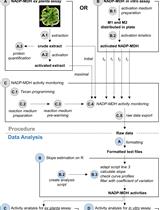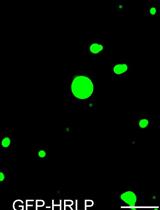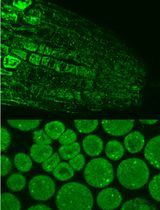- EN - English
- CN - 中文
Enzymatic Assays and Enzyme Histochemistry of Tuta absoluta Feeding on Tomato Leaves
对喂食番茄叶片的番茄潜叶蛾进行酶学测定和酶组织化学检测
发布: 2018年09月05日第8卷第17期 DOI: 10.21769/BioProtoc.2993 浏览次数: 7549
评审: Samik BhattacharyaSaptashati BiswasAnonymous reviewer(s)
Abstract
Enzymes play a key role in insect-plant relationships. For a better understanding of these interactions, we analyzed Tuta absoluta digestive enzymes. Here, we describe a detailed protocol for the detection of trypsin and papain-like enzymes in Tuta absoluta larvae by enzyme histochemistry. This assay uses frozen and unfixed samples to avoid the loss of enzymatic activity. We also describe a protocol for the quantification of trypsin and papain-like enzymes in the larvae of Tuta absoluta at different developmental instars.
Keywords: Tuta absoluta (番茄潜叶蛾)Background
Plants and insects have coexisted for million years and evolved a set of interactions which affect both organisms at different levels. Insects manage to develop different physiological and morphological adaptations to overcome plants defense mechanisms. Therefore, a better understanding of their vital functions would facilitate their targeted control. Different physiological functions in insects rely on enzymes: digestive, respiratory, circulatory, muscular, nervous, reproductive and endocrine. Several enzymes participate in the digestion. Proteases such as trypsin, chymotrypsin, pepsin or carboxypeptidases are responsible for protein digestion, which is a source of amino acids for the insect. Thus, digestive protease inhibitors have been successfully used to improve plant resistance to insects (Smigocki et al., 2013; Quilis et al., 2014; Hamza et al., 2018). In order to design such approaches, it is important to identify the target insect digestive enzymes. Enzyme histochemistry is a useful method for the localization of active enzymes in tissue sections of an organism. However, few protocols have been described for insects. One of the main issues of this method is the sensibility of the enzymes to fixatives. In a previous study, Erban and Hubert (2011) visualized the digestive enzymes in the body of the acarid mite Lepidoglyphus destructor after feeding them with chromogenic and fluorescent substrates taking advantage of their transparent body. This approach is not suitable for larvae of bigger insects such as Tuta absoluta. These larvae do not have transparent body allowing the visualization of the fluorescence and are reared with fresh tomato leaves instead of artificial diet and thus cannot be supplemented with enzymatic substrates. In our work, we designed a protocol for the detection of serine proteases and papain-like proteases in cryosections of larvae of Tuta absoluta without tissue fixation. We also quantified these enzymes in larvae at different instars using chromogenic substrates.
Materials and Reagents
- 1.5 ml microcentrifuge tubes
- Petri dishes (Thermo Fisher Scientific, SterilinTM, catalog number: 122TS1 )
- 1.5 ml pestles (Sigma-Aldrich, catalog number: Z359947-100EA )
- Tuta absoluta eggs
Note: The eggs were obtained from the Tuta absoluta colony reared in the IVIA (Instituto Valenciano de Investigaciones Agrarias). The colony was started with adults caught from tomato fields near Castellon (Spain). No commercial insects/eggs are available. - Tomato leaves (cv. Micro-Tom)
- Liquid nitrogen (commercial grade)
- European Bacteriological Agar (Conda, catalog number: 1800 )
- Acetone (Merck, catalog number: 1000141000 , CAS: 67-64-1)
- Bovine serum albumin (BSA Fraction V) (Roche, catalog number: 10 735 078 001 )
- Bradford reagent (Bio-Rad Laboratories, catalog number: 5000006 )
- Trichloroacetic acid (AppliChem, Panreac, catalog number: 131067 , CAS: 76-03-9)
- Nα-Benzoyl-L-arginine 4-nitroanilide hydrochloride (BApNA) (Sigma-Aldrich, catalog number: B3133 , CAS: 21653-40-7)
- pGlu-Phe-Leu p-nitroanilide (Sigma-Aldrich, catalog number: P3169 , CAS: 85901-57-1)
- Bovine trypsin (Sigma-Aldrich, catalog number: T1426 , CAS: 9002-07-7)
- Papain (Sigma-Aldrich, catalog number: P4762 , CAS: 9001-73-4)
- Nα-Benzoyl-L-arginine-7-amido-4-methylcoumarin hydrochloride (BAAMC) (Santa Cruz Biotechnology, catalog number: sc-301455 , CAS: 83701-04-6)
- NEG-50 gel (Thermo Fisher Scientific, catalog number: 6502 )
- Pills blister (capacity: approximately 400 µl) (Enantyum 25 mg, Menarini)
- Polyvinyl alcohol (Sigma-Aldrich, catalog number: P1763 , CAS: 9002-89-5)
- L-Cysteine (Sigma-Aldrich, catalog number: 168149 , CAS: 52-90-4)
- Ascorbic acid (Duchefa Biochemie, catalog number: A0602 , CAS: 50-81-7)
- Tris (Duchefa Biochemie, catalog number: T1501.1000 , CAS: 77-86-1)
- Sucrose (AppliChem, catalog number: 131621.1211 , CAS: 57-80-1)
- Polyvinylpyrrolidone (PVP) (Sigma-Aldrich, catalog number: PVP10 , CAS: 9003-39-8)
- Sodium phosphate (AppliChem, Panreac, catalog number: 122018.1210 , CAS: 7601-54-9)
- Calcium chloride 2 hydrate (AppliChem, Panreac, catalog number: 131232.1210 , CAS: 10035-04-8)
- Protein extraction buffer (see Recipes)
- Trypsin assay buffer (see Recipes)
- Papain assay buffer (see Recipes)
- Histochemistry wash solution 1 (see Recipes)
- Histochemistry wash solution 2 (see Recipes)
- Histochemistry substrate solution (see Recipes)
Equipment
- Pipettes (Gilson, 2-20,20-200 and 100-1,000 µl)
- Growth chamber (SANYO, model: MLR 350 )
- Binocular stereomicroscope (Olympus, model: SZ-St )
- Brush (Staedtler permanent, model: 989 4 BK2 )
- Stainless steel tweezers
- Spectrophotometer (Eppendorf, model: 6131 )
- Cryostat (Thermo Fisher Scientific, MICROM, model: HM520 )
- Refrigerated centrifuge (Eppendorf, model: 5417R )
- Fluorescence microscope (Leica, model: DM5000 B )
- Poly-lysine coated slides (Thermo Fisher Scientific, catalog number: J2800AMNZ )
- Camera (Nikon, model: D3200 )
Procedure
文章信息
版权信息
© 2018 The Authors; exclusive licensee Bio-protocol LLC.
如何引用
Hamza, R., Beltrán, J. P. and Cañas, L. A. (2018). Enzymatic Assays and Enzyme Histochemistry of Tuta absoluta Feeding on Tomato Leaves. Bio-protocol 8(17): e2993. DOI: 10.21769/BioProtoc.2993.
分类
植物科学 > 植物生物化学 > 蛋白质 > 活性
生物化学 > 蛋白质 > 活性
您对这篇实验方法有问题吗?
在此处发布您的问题,我们将邀请本文作者来回答。同时,我们会将您的问题发布到Bio-protocol Exchange,以便寻求社区成员的帮助。
Share
Bluesky
X
Copy link
















